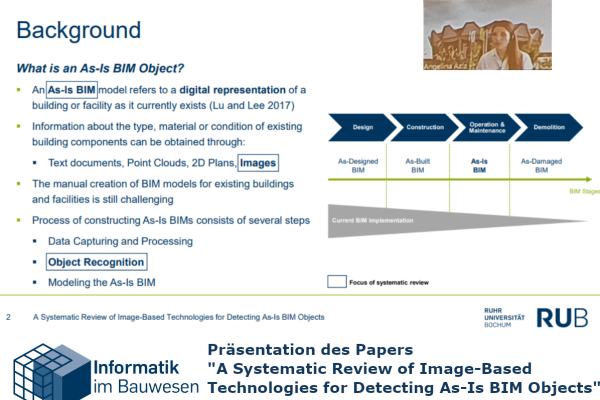08.10.2021

Under the motto " IT for Smart Infrastructure and Communities ", the University of Florida organized the "International Conference on Computing in Civil Engineering " (i3CE2021) from September 12 to 14, 2021.
There, the paper "A Systematic Review of Image-Based Technologies for Detecting As-Is BIM Objects" by the authors Angelina Aziz, Markus König and Jens-Uwe Schulz (Ostwestfalen-Lippe University of Applied Sciences) was presented.
The paper addresses object recognition for as-is BIM generation from images and provides a systematic overview of AI approaches for classification and recognition of building-related information in the field of construction and facility management, obtained through machine and deep learning methods.
The performance of object recognition methods strongly depends on the quality of images and extracted features, as well as the robustness of the classifiers, since the appearance can be affected by many factors such as the illumination conditions, the viewing angle, and the reflection of objects.
Image features can be divided into three categories (Sitaula et al. 2019):
1. low-level (e.g., color intensity, texture).
2. medium-level (e.g., shape, objects)
3. high-level (e.g. contextual information).
Most classical machine learning methods are limited to extracting only low-level and mid-level semantic information. They rely on prior knowledge and recognition rules and are usually based on classifiers such as Support Vector Machine (SVM) or other classification algorithms in combination with selected feature detectors.
In recent years, neural networks have attracted more attention as they are now able to automatically extract high-level features from a training dataset (-> "high-level").
So, the combination of machine and deep learning methods could enable robust recognition of BIM objects in images in the future.
If not enough data is available for training, methods exist that may be able to increase performance and accuracy. The generation of synthetic images from a BIM model can be transferred to a set of real images, thus increasing the training set. In addition, the use of transfer learning provides a pre-trained system that can be fine-tuned for the recognition task at hand. In addition, automated image annotation of training images can save a lot of time.
Under the motto " IT for Smart Infrastructure and Communities ", the University of Florida organized the "International Conference on Computing in Civil Engineering " (i3CE2021) from September 12 to 14, 2021.
There, the paper "A Systematic Review of Image-Based Technologies for Detecting As-Is BIM Objects" by the authors Angelina Aziz, Markus König and Jens-Uwe Schulz (Ostwestfalen-Lippe University of Applied Sciences) was presented.
The paper addresses object recognition for as-is BIM generation from images and provides a systematic overview of AI approaches for classification and recognition of building-related information in the field of construction and facility management, obtained through machine and deep learning methods.
The performance of object recognition methods strongly depends on the quality of images and extracted features, as well as the robustness of the classifiers, since the appearance can be affected by many factors such as the illumination conditions, the viewing angle, and the reflection of objects.
Image features can be divided into three categories (Sitaula et al. 2019):
1. low-level (e.g., color intensity, texture).
2. medium-level (e.g., shape, objects)
3. high-level (e.g. contextual information).
Most classical machine learning methods are limited to extracting only low-level and mid-level semantic information. They rely on prior knowledge and recognition rules and are usually based on classifiers such as Support Vector Machine (SVM) or other classification algorithms in combination with selected feature detectors.
In recent years, neural networks have attracted more attention as they are now able to automatically extract high-level features from a training dataset (-> "high-level").
So, the combination of machine and deep learning methods could enable robust recognition of BIM objects in images in the future.
If not enough data is available for training, methods exist that may be able to increase performance and accuracy. The generation of synthetic images from a BIM model can be transferred to a set of real images, thus increasing the training set. In addition, the use of transfer learning provides a pre-trained system that can be fine-tuned for the recognition task at hand. In addition, automated image annotation of training images can save a lot of time.